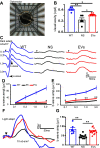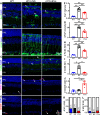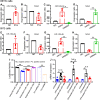Mesenchymal stem cell-derived extracellular vesicles protect retina in a mouse model of retinitis pigmentosa by anti-inflammation through miR-146a-Nr4a3 axis
- PMID: 35922863
- PMCID: PMC9351183
- DOI: 10.1186/s13287-022-03100-x
Mesenchymal stem cell-derived extracellular vesicles protect retina in a mouse model of retinitis pigmentosa by anti-inflammation through miR-146a-Nr4a3 axis
Abstract
Background: Retinitis pigmentosa is a rod-cone degenerative disease that induces irreversible vision loss. This study probed the protective capacity of mesenchymal stem cell-derived small EVs (MSC-EVs) on the retinas of rd10 mice and the underlying mechanism.
Methods: MSC-EVs were injected into the vitreous of rd10 mice at postnatal day 14 and P21; morphology and function were examined at P28. The mechanism of action was explored by using co-culture of photoreceptor cell line 661 W and microglia cell line BV2.
Results: Treatment with MSC-EVs increased the survival of photoreceptors and preserved their structure. Visual function, as reflected by optomotor and electroretinogram responses, was significantly enhanced in MSC-EVs-treated rd10 mice. Mechanistically, staining for Iba1, GFAP, F4/80, CD68 and CD206 showed that MSC-EVs suppressed the activation of microglial, Müller glial and macrophages. Furthermore, western blotting showed that the treatment inhibited the NF-κB pathway. RNA-seq and qPCR showed that MSC-EVs upregulated anti-inflammatory cytokines while downregulating pro-inflammatory cytokines. MSC-EVs application in vitro decreased the number of TUNEL-positive 661 W cells co-cultured with LPS-stimulated BV2, with similar impact on the cytokine expression as in vivo study. Genetic screening predicted miR-146a to be the downstream target of MSC-EVs, which was detected in MSC-EVs and upregulated in co-cultured 661 W cells and BV2 cells after MSC-EVs treatment. Upregulation of miR-146a by using its mimic decreased the expression of the transcription factor Nr4a3, and its downregulation inhibition promoted Nr4a3 expression in both 661 W and BV2 cells. Nr4a3 was further identified as the target gene of miR-146a by dual-luciferase assay. Furthermore, overexpressing miR-146a significantly decreased the expression of LPS-induced pro-inflammatory cytokines in BV2 cells.
Conclusions: MSC-EVs delays retinal degeneration in rd10 mice mainly by its anti-inflammatory effect via the miR-146a-Nr4a3axis. Hence, MSC-EVs may be used in the treatment of neurodegenerative diseases.
Keywords: Extracellular vesicles; Inflammation; Retinitis pigmentosa; miR-146a-Nr4a3 axis; rd10 mouse.
© 2022. The Author(s).
Conflict of interest statement
The authors declare that they have no competing interests.
Figures








Similar articles
-
MicroRNA-based engineered mesenchymal stem cell extracellular vesicles to treat visual deficits after blast-induced trauma.Exp Eye Res. 2024 Oct;247:110031. doi: 10.1016/j.exer.2024.110031. Epub 2024 Aug 10. Exp Eye Res. 2024. PMID: 39128668
-
Human Infrapatellar Fat Pad Mesenchymal Stem Cell-derived Extracellular Vesicles Purified by Anion Exchange Chromatography Suppress Osteoarthritis Progression in a Mouse Model.Clin Orthop Relat Res. 2024 Jul 1;482(7):1246-1262. doi: 10.1097/CORR.0000000000003067. Epub 2024 Apr 19. Clin Orthop Relat Res. 2024. PMID: 38662932 Free PMC article.
-
Extracellular vesicles derived from clonal mesenchymal stromal cells preconditioned by indirect hypoxia modulate immune responses in diabetic mice more effectively than directly preconditioned vesicles.Stem Cell Res Ther. 2025 Aug 26;16(1):458. doi: 10.1186/s13287-025-04568-z. Stem Cell Res Ther. 2025. PMID: 40859321 Free PMC article.
-
Mesenchymal Stem Cell-Derived Extracellular Vesicle Therapy for Asthma in Murine Models: A Systematic Review and Meta-analysis.Stem Cell Rev Rep. 2024 Jul;20(5):1162-1183. doi: 10.1007/s12015-024-10704-8. Epub 2024 Mar 16. Stem Cell Rev Rep. 2024. PMID: 38492133
-
Navigating the future of retinitis pigmentosa treatments: A comprehensive analysis of therapeutic approaches in rd10 mice.Neurobiol Dis. 2024 Apr;193:106436. doi: 10.1016/j.nbd.2024.106436. Epub 2024 Feb 8. Neurobiol Dis. 2024. PMID: 38341159 Review.
Cited by
-
Exosomal miR-146a-5p derived from human umbilical cord mesenchymal stem cells can alleviate antiphospholipid antibody-induced trophoblast injury and placental dysfunction by regulating the TRAF6/NF-κB axis.J Nanobiotechnology. 2023 Nov 13;21(1):419. doi: 10.1186/s12951-023-02179-5. J Nanobiotechnology. 2023. PMID: 37957714 Free PMC article.
-
MiR-146a reduces fibrosis after glaucoma filtration surgery in rats.J Transl Med. 2024 May 8;22(1):440. doi: 10.1186/s12967-024-05170-2. J Transl Med. 2024. PMID: 38720358 Free PMC article.
-
Ghrelin Induces Ferroptosis Resistance and M2 Polarization of Microglia to Alleviate Neuroinflammation and Cognitive Impairment in Alzheimer's Disease.J Neuroimmune Pharmacol. 2025 Jan 11;20(1):6. doi: 10.1007/s11481-024-10165-3. J Neuroimmune Pharmacol. 2025. PMID: 39797928
-
Mesenchymal stem cell-derived small extracellular vesicles enhance the therapeutic effect of retinal progenitor cells in retinal degenerative disease rats.Neural Regen Res. 2026 Feb 1;21(2):821-832. doi: 10.4103/NRR.NRR-D-23-02108. Epub 2024 Jul 29. Neural Regen Res. 2026. PMID: 39101643 Free PMC article.
-
Cell Therapy for Retinal Degenerative Diseases: Progress and Prospects.Pharmaceutics. 2024 Oct 5;16(10):1299. doi: 10.3390/pharmaceutics16101299. Pharmaceutics. 2024. PMID: 39458628 Free PMC article. Review.
References
Publication types
MeSH terms
Substances
LinkOut - more resources
Full Text Sources
Miscellaneous

